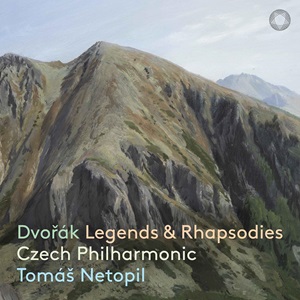
Antonín Dvořák (1841-1904)
Legends, Op 59, B.122 (1881)
Slavonic Rhapsodies, Op 45, B.86 (1878)
Czech Philharmonic Orchestra/Tomáš Netopil
rec. 2021 (Legends) and 2023 (Rhapsodies), Dvořák Hall of the Rudolfinum, Prague
Pentatone PTC 5187 221 [80]
Neither the Legends nor the three Slavonic Rhapsodies are at the top of anyone’s list of Dvořák’s most popular works. They may both have been the product of his early maturity, but the Legends have long been surpassed by the Slavonic Dances as exemplars of Bohemian brilliance and the Rhapsodies aren’t as popular or musically satisfying as some of the tone poems. That said, a good new recording will always make a case for them.
Tomáš Netopil and the Czech Philharmonic recorded the Legends in November 2021 and the Rhapsodies in January 2023, in the Rudolfinum. The first thing to note is that I’m not sure that Pentatone’s recording team has successfully dealt with the venue. For all the Rudolfinum’s architectural beauty it can be a tricky venue to record and there’s a lack of definition to the sound that can blunt attacks. Maybe this contributes to my relative disappointment and colours what follows.
The Legends were originally composed for piano duet and rapidly orchestrated by Dvořák for his publisher Simrock, in time to cash in on the vogue for such works. Netopil is on a par with Mackerras and the same orchestra when it comes to timings and the general critical consensus these days – try Fischer and his Budapest Festival forces – aligns with him too. Kubelík and his Bavarian forces offer much wonderful music-making, but their recording quality is also rather cloudy. If you came to the cycle for the first time in Netopil’s recording, you’d probably find him accomplished and lively, but that’s only if you’d never heard Šejna and the Czech Philharmonic’s recording of 1956. This operates on a different level of characterisation and rhythmic subtlety. He can draw back the tempo slightly, give prominence to the famous Czech winds of the time, allow the dance patterns to crest and fall and crest again. Then again, when he needs to – and he needs to in No 2 – Šejna is snappier, less honeyed and more vivacious than Netopil – and Mackerras and Fischer too for that matter. In No 7 Sejna’s greater ear for colouration, and for which voices should predominate, makes everyone else sound fairly insipid. Netopil isn’t bad here, but he hustles the music and lacks Šejna’s affection for it.
Netopil’s Rhapsodies follow on from the recording made a few years ago by Jakob Hrůša with the Prague Philharmonia and their tempos are almost identical. Those of you who may have the long-standing Czech Philharmonic recording from Bohumil Gregor may find his tempi a little on the plump side alongside those of the younger Czech Lions. Netopil responds to the Rhapsodies rather better than the Legends and one feels him working in longer lines, taking opportunities to risk more on these very much bigger canvases – they each last about thirteen minutes. The harp is an audible presence in the Rhapsody in G minor and Netopil negotiates its furiant with accomplishment. The result is fiery and excited, blunted only by the recording quality. The bardic, Smetana-influenced No 3, with its Má Vlast echoes is also attractively done, not least the chattering, increasingly roistering Polka.
The documentation is in the safe hands of Jan Smaczny. Pentatone has released a number of discs to mark this ‘Year of Czech Music’, among them Dvořák’s Symphonies 7-9 and Smetana’s Má Vlast, all conducted by Semyon Bychkov. This latest release is, like those others, only partially successful.
Jonathan Woolf
Buying this recording via a link below generates revenue for MWI and helps us keep free access to the site



















